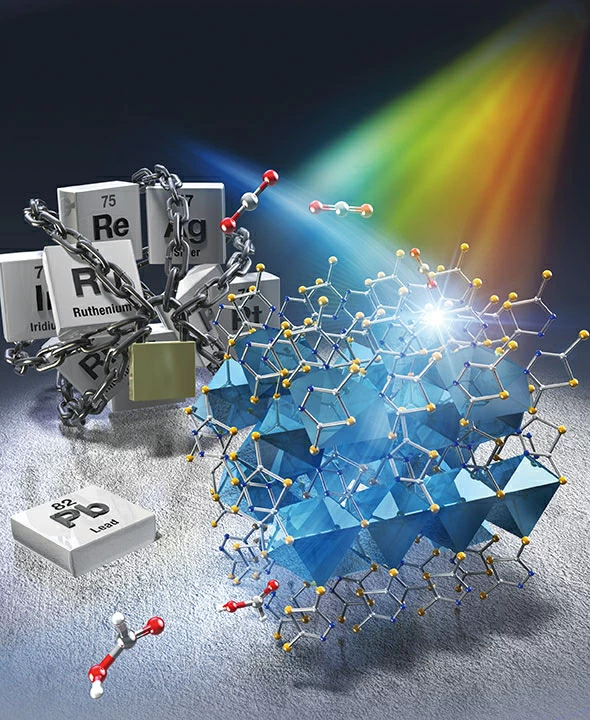Scientists at Tokyo Tech are encouraged by the exceptional performance of a new coordination polymer-based photocatalyst for CO2 reduction in the fight against global warming.
 This scientific illustration of the study was selected as a Cover Picture in ACS Catalysis. Image Credit: Tokyo Institute of Technology, ACS Catalysis.
This scientific illustration of the study was selected as a Cover Picture in ACS Catalysis. Image Credit: Tokyo Institute of Technology, ACS Catalysis.
This potential photocatalyst, composed of abundant elements and does not require any elaborate post-synthesis processing or changes, may open the door to a new class of photocatalysts capable of effectively transforming CO2 into useful chemicals.
One of the main contributors to global warming is CO2 emitted into the atmosphere when fossil fuels are burned. Creating CO2 reduction technologies that turn CO2 into valuable molecules like CO and formic acid (HCOOH) is one strategy to combat this growing issue. Particularly, photocatalytic CO2 reduction systems operate in a manner similar to how plants conduct photosynthesis by utilizing visible or ultraviolet light to cause CO2 reduction.
Numerous advanced photocatalysts based on coordination polymers (CPs) and metal-organic frameworks have been discovered by scientists in recent years. Unfortunately, most are either constructed of costly metals or call for intricate post-synthesis alterations.
A research team from Japan has discovered a solution to these problems in a paper that was published in the journal ACS Catalysis.
The Tokyo Institute of Technology (Tokyo Tech) team, under the direction of Specially Appointed Assistant Professor Yoshinobu Kamakura and Professor Kazuhiko Maeda, created a novel type of photocatalyst for CO2 reduction based on a CP having lead–sulfur (Pb–S) bonds. The novel CP, denoted KGF-9, is composed of an endless (–Pb–S–)n structure and exhibits unique features.
For example, KGF-9 has a low surface area because it lacks pores and voids. It still managed to perform photoreduction spectacularly, though. KGF-9 showed an effective quantum yield (product yield per photon absorbed) of 2.6% and a selectivity of over 99% in the conversion of CO2 to formate (HCOO−) when exposed to visible light at 400 nm.
These values are the highest yet reported for a precious metal-free, single-component photocatalyst-driven reduction of CO2 to HCOO−. Our work could shed light on the potential of nonporous CPs as building units for photocatalytic CO2 conversion systems.
Kazuhiko Maeda, Professor, Tokyo Institute of Technology
Compared to other photocatalysts, KGF-9 performs admirably and is simpler to make and utilize. KGF-9 does not necessitate the presence of a cocatalyst, like metal nanoparticles or metal complexes, because the active Pb sites (where CO2 reduction takes place) are already “installed” on its surface.
Additionally, it may function at ambient temperature and under visible light illumination without requiring any extra post-synthesis alterations.
To expand KGF-9’s surface area and improve its performance, the Tokyo Tech team is already considering new tactics. KGF-9 has a strong probability of opening the door to a more economically viable CO2 reduction because it is the first photocatalyst with Pb(II) as the active center.
The researchers conclude, “We believe that our study provides an unprecedented opportunity for developing a new class of inexpensive photocatalysts for CO2 reduction consisting of earth-abundant elements.”
Additional studies in this area might help in the fight against climate change.
Journal Reference:
Kamakura, Y., et al. (2022) Selective CO2-to-Formate Conversion Driven by Visible Light over a Precious-Metal-Free Nonporous Coordination Polymer. ACS Catalysis. doi.org/10.1021/acscatal.2c02177.